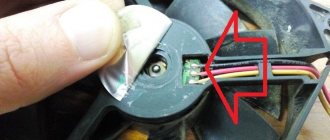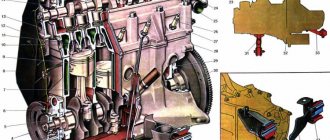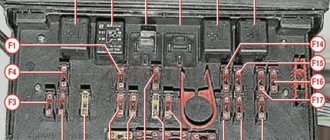VAZ cooling fan connection diagram
All the main electrical circuits and modifications for connecting the liquid cooling fan (CO) in VAZ cars of various models are provided. What is the essence of VO’s work? An electric motor with an impeller on a shaft is installed inside a rectangular metal frame, with which it is attached to the back of the radiator. When voltage (12 V) is applied to the contacts of the drive, it begins to work, rotating the blades and creating a directed stream of air, which, in fact, cools the antifreeze or antifreeze.
If the cooling fan does not work, do not rush to contact a car service. You can determine the cause of the malfunction yourself. Moreover, it is not at all necessary to have special skills for this - just study the reference material from 2shemi.ru and follow the instructions for checking/replacing it.
Button connection diagram
To be able to turn on the fan manually, the VAZ 2114 fan button is installed in the on-board network parallel to the thermal relay, which is triggered when the coolant temperature rises. There are two options for connecting the button: directly or using an electromagnetic relay.
In the first case, too much current will flow through the button contacts and will quickly fail. Therefore, correct connection of the fan must be done only through a relay. In this case, only a small current will pass through the button, controlling the relay electromagnet. A pair of wires is connected to the terminals of the relay contacts (those that are open when there is no power to the electromagnet): one from the output of the thermal relay, the other from the input. In this case, when voltage is applied to the relay electromagnet, the radiator fan will turn on. The “ground” of the relay can be connected to the nearest bolt, and the “plus” can be connected from the fuse block. Moreover, it is better to connect it to the output of the fuse, which is de-energized when the ignition is off. For example, to fuse F10. In this case, even if you forget to turn off the fan, it will stop working after turning off the ignition. Otherwise, there is a risk of draining the battery to zero by leaving the car in the parking lot with the fan on.
Fan connection 2108, 2109, 21099
Until 1998, on cars with the old mounting fuse block 17.3722 (finger type fuses), relay 113.3747 was included in the fan circuit. After 1998 there is no such relay.
Also, before 1998, the TM-108 switching sensor was used (the closing temperature of its contacts is 99±3ºС, the opening temperature is 94±3ºС), after 1998 the TM-108-10 with similar temperature ranges or its analogues from different manufacturers. The TM-108 sensor only works in conjunction with a relay; the TM-108-10, reinforced for high current, can work both with and without a relay.
Scheme for switching on the engine cooling fan on a VAZ 2109 with mounting block 17.3722
- Fan motor
- Motor start sensor
- Mounting block
- Ignition switch
K9 - Relay for turning on the fan motor. A - To terminal “30” of the generator
Scheme for switching on the engine cooling fan on a VAZ 2109 with mounting block 2114-3722010-60
- Fan motor
- Sensor 66.3710 for turning on the electric motor
- Mounting block
A - To terminal “30” of the generator
Forced fan VAZ 2107: methods and circuit diagram
This article will talk in detail about the VAZ 2107 forced-air fan. Two types of this design can be distinguished - electrical and mechanical. Any owner of a 7 begins to regret that in the summer, in a traffic jam, his fan switch suddenly fails. After such an incident, as a rule, they begin to think about improving the design. And modernization can be done in several ways.
Connection diagram for VO VAZ 2110
The circuit diagram for switching on the cooling fan of the VAZ 2110 on carburetor and injection cars is different. On cars with a carburetor engine, a thermobimetallic sensor TM-108 is used for this, and on cars with an injection engine, control is carried out by a controller.
Circuit diagram for switching on the cooling fan for a VAZ 2110 injection engine.
The circuit for switching on the cooling fan of a VAZ 2110 with an injection engine is powered by an electronic engine control controller. The response temperature in this case is set in the controller program and can be from 100 to 105 degrees. C. If the temperature sensor malfunctions, the error code P0115, P0116, P0117, P0118 is entered into the controller’s memory and the fan turns on while the engine is running.
A radiator fan with such a drive has its own operating principle, perhaps the most common in modern automobile production. This cooling mechanism includes an electric motor and a control system. The electric motor itself is powered from the vehicle's on-board network. The smart control system itself calculates the operation of the radiator fan, focusing on the degree of engine heating. Many modern cars already have a controlled fan run-on function. This is done so that after stopping the car and turning off the engine, the fan would blow on the engine. The control system will select the “cooling” mode independently, based on the degree of heating of the car engine.
Connection diagram for the electric motor of the VAZ 2107 engine cooling system fan:
Where is the fan relay located?
4 – electric fan relay; 5 – electric fuel pump relay; 6 – main relay (ignition relay).
Attention: the order of the relays and fuses can be arbitrary, we are guided by the color of the wires. Therefore, we find a relay from which comes a thin pink with a black stripe wire coming from the main relay (pin 85*) (not to be confused with the thin, red with a black stripe wire coming from the controller) and a thick power white with a black stripe wire (pin 87) (white and pink wires we need), this is the fan relay.
If the cooling fan does not work
To drive the fan, a DC electric motor with excitation from permanent magnets ME-272 or similar is installed. Technical data of the electric fan and fan switch sensor:
- Rated rotation speed of the electric motor shaft with impeller, 2500 – 2800 rpm.
- Electric motor current consumption, 14 A
- Sensor contact closure temperature, 82±2 degrees.
- Sensor contact opening temperature, 87±2 degrees.
The cooling system fan may not turn on due to:
- electric drive malfunctions;
- blown fuse;
- faulty thermostat;
- a failed thermal sensor for turning on the cooler;
- faulty VO relay;
- broken electrical wiring;
- faulty expansion tank plug.
To check the VAZ fan electric motor itself, we apply 12 V voltage from the battery to its terminals - a working motor will work. If the problem is with the fan, you can try to repair it. The problem is usually the brushes or bearings. But it happens that the electric motor fails due to a short circuit or break in the windings. In such cases, it is better to replace the entire drive.
The BO fuse is located in the mounting block of the car's engine compartment and is designated F7 (20 A). The test is carried out using a car tester turned on in probe mode.
- In a car with a carburetor engine, you need to check the sensor - turn on the ignition and short-circuit the two wires going to the sensor. The fan should turn on. If this does not happen, the problem is definitely not with the sensor.
- For injection cars, it is necessary to warm up the engine to operating temperature and disconnect the sensor connector, disconnecting it from the vehicle’s on-board network. In this case, the controller must start the fan in emergency mode. The electronic unit perceives this as a failure in the cooling system and forces the fan drive to operate in constant mode. If the drive starts, the sensor is faulty.
Replacing an electric fan in a car
- We park the car on a flat surface and immobilize it with the parking brake.
- Open the hood and disconnect the negative terminal.
- Using a 10mm wrench, unscrew the fastenings of the air filter housing.
- Using a screwdriver, loosen the air duct clamp on the air flow sensor and remove the corrugation.
- We unscrew the screws securing the cover of the air filter housing and remove the filter element.
- Using a size 8 wrench, unscrew the air intake mount and remove it.
- Using a 10mm wrench, then an 8mm wrench, unscrew the nuts securing the fan casing around the perimeter (6 pieces in total).
- Disconnect the wire block on the fan connector.
- Carefully remove the fan casing along with the drive.
- Using a 10mm wrench, unscrew the 3 bolts holding the electric motor to the casing.
- We put a new one in its place.
- We install the structure in place, fix it, and connect the connector.
- We carry out further installation in the reverse order.
Control circuit modernization
The cooling fan on the top ten turns on at a temperature of 100-105°C, while the normal operating temperature of the engine is 85-90°C, so the fan turns on when the engine overheats, which naturally has a negative effect.
This problem can be solved in two ways: adjust the switch-on temperature in the “brains” or make a button. We'll focus on the second one. Turning on the fan from the button is very convenient: if you get into a traffic jam, turn it on, drive out, turn it off, and no overheating occurs.
A button for selecting the fan operating mode was installed in the cabin (always off, constantly on, automatically turned on via a sensor) - this “tuning” is not mandatory, but will be a very useful addition.
There will be a large current at relay contacts 87, 30, on the wire from the battery to the fuse and the fan ground, and therefore we must use wires there with a cross-section of at least 2 mm, otherwise the thinner wire will not withstand it and will burn out.
Cooling system design features
Depending on the design features, the fan can be turned on in 3 ways:
- using a power sensor for activation of the VSO. This sensor is also called a fan temperature relay, since the power contacts of the electric motor pass directly through the sensor. With this scheme, the load on the thermal relay increases significantly, which reduces its service life;
- using the fan switch sensor, but now closing the contacts in the temperature switch triggers the relay, through which the power contacts of the cooling fan are connected. This connection method is much more reliable than the previous option;
- using an electronic engine control unit. The ECU, focusing on the coolant temperature sensor installed in the engine cooling radiator, supplies power to the VCO through a relay. A resistive temperature sensor is used as a meter. It is this switching circuit that is used on the vast majority of modern cars. On cars equipped with air conditioning, one of the electric fans will be controlled by the comfort unit. This is necessary for forced cooling of the condenser when the interior air conditioning system is activated.
Operating modes
When understanding the operating principle and connection diagram of a radiator fan, you should remember that electric motors often have two speed modes. This is implemented in 2 ways:
- by adding a resistor to the circuit, which increases the resistance and, as a result, reduces the current. The design uses a two-contact sensor, which, depending on the temperature, powers the electric motor directly or through resistors;
- a combination of parallel and series connection. The circuit is used on a car with two fans. They can be connected in series, in which case, according to Ohm's law, they will operate from 6 V, or in series, when 12 V is supplied to each of the VSOs. The modes correspond to low and high speed rotation of the propeller.
Renault Logan radiator fan, connection diagram
On first-generation Renault Logan cars, the radiator fan of the engine cooling system (k7j, k7m) can be connected using two different circuits.
For cars without air conditioning - one circuit (fewer elements), for cars with air conditioning - another (more elements). Both diagrams can be useful when diagnosing a malfunction: “Renault Logan radiator fan does not work.”
Connection diagram for the radiator fan of a Renault Logan first generation car without air conditioning (engine k7j, k7m)
Description of the scheme
In the system for turning on the fan on the radiator of a Renault Logan car without air conditioning, voltage is supplied from the positive terminal of the battery through the mounting fuse block in the engine compartment.
The electrical circuit is protected by green fuse F02 (30A) installed in the mounting block in the engine compartment. This fuse is not available on vehicles equipped with air conditioning. There the circuit is protected by another fuse.
Fan relay K3 (20A) is the main relay for turning on the fan on the radiator (in configurations with air conditioning it comes as a low-speed fan relay). In the configuration without air conditioning there is only one fan speed.
The fan motor is supplied with voltage directly from the fan relay (K3) in the mounting block under the hood of the car. There is no additional resistor on the casing.
The coolant temperature sensor (CTS), based on the signal from which the control unit turns the fan on the radiator on and off, is installed in the left end of the engine cylinder head. In addition to determining the temperature for the ECU, it determines the temperature for the indicator in the instrument cluster.
Connection diagram for the radiator fan of a Renault Logan first generation car with air conditioning (k7m engine)
Description of the scheme
In the system for turning on the fan on the radiator of a Renault Logan car equipped with an air conditioner, voltage is supplied from the positive terminal of the battery through the mounting fuse block in the engine compartment.
The electrical circuit is protected by red fuse F07 (40A) installed in the mounting block in the engine compartment. On vehicles without air conditioning, this fuse is not available. There the circuit is protected by another fuse.
There are two relays in the circuit. The low-speed radiator fan relay (also known as the fan turn-on relay in configuration b) K3 (20A) and the high-speed radiator fan relay K2 (40A) are larger in size.
An additional resistor is installed on the fan casing, which serves to reduce the fan speed (low rotation speed). When the coolant temperature threshold reaches 95-97 degrees or when the air conditioner is turned on, the control unit supplies voltage to the electric radiator fan through a low speed relay and an additional resistor. If the threshold level is passed, then voltage is supplied to the fan through the high speed relay, bypassing the additional resistor. In this case, the fan blades rotate twice as fast.
Notes and additions
The radiator fan is one of the actuators of the electronic engine control system (ECM) of the Renault Logan car. It is turned on/off by a signal from the controller (control unit - ECU).
The color of the wires on cars of different years (months) of production may vary slightly.
TWOKARBURATORS VK -More information on the topic in our VKontakte group
Scheme options
Schematic diagram of VSO connection on VAZ 2108, 2109, 21099 (until 1998).
As we can see, the sensor controls the fan relay, which is located in the fuse box. When a certain temperature is reached, the contacts of the temperature switch close, which leads to the flow of current in the electric motor circuit.
Above is a diagram for VAZ 2108, 2109, 21099 cars, but after 1998. As we can see, the power sensor now functions as a relay.
Let's consider a circuit using a resistor to implement two propeller rotation speeds using the VW Passat as an example. The two-position fan power sensor S23, depending on the coolant temperature, closes the contacts directly or through an additional resistance.
DIY connection
Some drivers, warning the engine against overheating due to improper operation of the radiator fan power supply thermal relay, make an external button to force the electric motor to turn on. To do this, it is enough to connect a fixed button in parallel to the control output of the relay coming from the sensor, which, when pressed, will close the contact to ground, thereby provoking the operation of the relay. If the car's design does not provide a fan relay, you will have to install it yourself to force cool the radiator.
Under no circumstances should you connect the electric motor directly through the button in the cabin! We also do not recommend connecting the circuit so that after turning on the ignition the electric fan constantly rotates, as this significantly reduces its service life.
To connect, you only need to understand the operating principle of a 4-pin relay and minimal knowledge in installing additional equipment. Be sure to include a fuse of the correct rating in the power circuit and place it as close to the power source as possible (read more about how to choose the correct fuse rating).
If desired, you can replace the single-position sensor with a two-position one, which, paired with a selected resistor, will allow you to realize a low speed of operation of the VSO. If you have a sufficient level of knowledge in electrical engineering, then you can build a PWM controller to adjust the speed of rotation of the propeller. Controlling the electric fan using a PWM signal will allow you to smoothly regulate and arbitrarily select the rotation speed depending on the temperature load on the engine. There is enough material on the Internet on how to make a PWM controller with your own hands.
Using an electromagnetic relay
Using a simple relay will slightly complicate the circuit, but will relieve the temperature sensor from the presence of high current. A large current will flow through the relay contacts. It is cheaper and easier to replace the relay than the temperature sensor to turn on the electric fan. To carry out the upgrade, you will need a wire and a relay with a bracket for mounting to the body.
Disconnect the temperature sensor, and the wires that were on it must be connected to the normally open pair of contacts of our relay. Half the job is done, the power part is ready. Now control. We connect one terminal of the temperature sensor to ground, but connect the second to the relay coil.
From the second terminal of the coil you need to stretch the wire to the positive terminal of the battery. It is advisable that the connection be made through a fuse, the operating current of which can be 1 Ampere. The coil consumes a small amount of current, so the worst thing that can happen is a short circuit in the wiring. Subsequently, you can connect a forced activation button in parallel with the temperature sensor, which you will install in the car interior.
Making a 2-speed cooling fan for a VAZ
This solution allows you to get rid of frequent switching on of the cooling fan , there are no voltage drops (although I didn’t have any due to a good generator and an automatic LV at 14.5V), and the idle speed does not drop when the fan is turned on. And there is no vibration in the body with the original 4-blade fan. The normal operation of the cooling fan remained in place.
The cooling fan now turns on at half power at a temperature of 92 degrees, and the maximum speed will be when it reaches 96 degrees.
This is what happened:
For this we needed the following components:
1…
Tee for a cooling sensor from a gazelle, costing 150 rubles.
Sawed by a Bulgarian's wife and rolled with a hammer and filed. 2... DTOZH from the classics 92/87 degrees. 100 rubles. 3... 2 clamps for the pipe. What size - I don't know. Just fit this pipe and that’s it... 4... 4-pin relay for 70 A + connector. Cost 160 rubles with chip. 5... 30 A remote fuse. I installed a 30 pin relay in the power circuit. 6... Crimping chips + crimping (can be done with narrow pliers) and heat shrinking. 7... Miscellaneous wires 4 meters. 8... Mom/Dad chips for the fan, because I didn’t want to cut the insulation. The “original” fan chip is disconnected, our purchased one is connected to each other, the positive contact is isolated, and the negative contact is used to connect the signal from the relay to it. 9... Resistance from a classic stove is 1.5 ohms.
You can put a resistance of 2-2.5 Ohms, but I couldn’t find the resistance from the UAZ stove in my city. So we are content with what we have. The fan is supplied with 6.6 V according to the tester. The lower radiator pipe is cut if your radiator is a new model without a plug for the DTOZH. Place the tee so that the sensor contacts are at 90 degrees, and not as in my photo (I almost missed this point, the stove body does not sit properly). But this will be corrected when replacing the coolant. If you have an old-style radiator, or a Luzarovsky universal one, then you do not need to cut the pipe. These radiators have a plug for the DTOZH.
87…
we twist the contact or solder it to the black wire of the fan (focus on the wires from the fan itself, and not on the central wiring, because the colors may differ. Another option is to call with a multitester).
“Plus” is supplied to the fan permanently, but it is controlled by a mass signal (it may differ depending on the year of manufacture judging by the comments). 86...
the contact can be connected directly to the “positive” terminal of the battery.
The relay winding does not draw voltage. 85...
we connect the relay contact into the gap through the coolant temperature sensor (DTOZH).
The sensor in our case acts as an automatic button. 30...
we connect the contact directly to the negative terminal of the battery through a fuse, then we connect a resistance resistor and then to the relay.
The resistance resistor itself was pulled to the cooling fan housing with a regular clamp. Mount the resistor in the area of the air flow from the fan to cool it. It heats up well during operation.
In general, everything... During the entire evening of active driving and traffic jams, the fan never turned on fully. Everything is automatic, there are no surges or drops in rpm at idle. I like. The fan continues to run briefly even after the ignition is turned off.
You can also add a button to force the fan into this circuit without any problems - be sure to use a relay, the control plus of the relay coil (pin 85 for example) is taken from the main relay from the passenger compartment, the control minus (pin 86) through the fan switch button, on pins 30 and 87 connect the DTOZh contacts. All this is necessary so that the fan turns off when the ignition is turned off and eliminates the possibility of constant operation of the fan if the driver forgets. Although IMHO this button is superfluous with this solution.
Well, by the way, this scheme can also be used for carb cars. You just need a sensor, one “chisel” for the radiator, and the second “classic” for the tee (although it can be done the other way around). Well, that is if you can’t find a 2-mode fan switch sensor from a foreign company.
P/S..
We installed the same for a friend on a VAZ 2115, 2006. — according to the diagram, it was necessary to change the polarity of the voltage supply to the fan. It is controlled not by “minus”, but by “plus”.
Connecting the engine cooling fan
- Connecting the engine cooling fan
- 1. Design and purpose of the engine cooling fan
- 2. Installation and connection of the fan
- 3. Refinement of the fan motor switching circuit
We all know that when almost any mechanism operates, a certain amount of heat is generated.
In everyday life, a similar phenomenon can most often be observed when the computer is running, and if it is not cooled in any way, the internal boards along with the contacts will simply melt. To prevent this from happening, the computer design includes a special fan designed to cool heated parts. In the automotive world, the main source of heat for a vehicle is its engine, so the need for its cooling arose almost simultaneously with the creation of this power unit. Initially, the process of evolution of vehicle cooling systems followed two paths, which is why two types of cooling systems are installed on manufactured vehicles: air and liquid (hybrid). Since in both systems the final carrier, designed to dissipate the heat removed from the engine, is air, their design uses one common element - a fan. This device ensures constant and uniform heat removal into the atmosphere, thereby cooling the internal structural elements of a car engine.
Design and purpose of an engine cooling fan
As we have already said, a running engine is a powerful heat emitter, and in order to avoid overheating of the unit itself, this heat must be removed. The solution to this problem relies on various cooling systems.
For example, in a liquid engine cooling system, water or antifreeze is used as the main working element.
The fluid circulates in the cylinder block and in the cylinder head, where it takes heat from the engine, thereby heating itself. Naturally, in order to successfully perform its duties, the coolant must release the heat it receives in order to perform the same function again. This is where the radiator comes into play.
The location of the radiator of the cooling system of a car engine allows it to “catch” flows of incoming air when the car is moving, which significantly accelerates heat transfer, which means the liquid cools faster. However, a car cannot be in motion all the time, therefore, in traffic jams or during long periods of parking, when the vehicle does not move, but its engine continues to work, the heat from the radiator is removed much worse, which often causes overheating of the engine with all the ensuing consequences. This result can also be obtained due to the vehicle moving at low speeds, especially on a hot summer day.
The fan located in front of the radiator prevents such situations and provides the engine with the necessary cooling.
It turns on when the car is idle for a long time with the engine running, when the temperature in the cooling system becomes critical. The fan disperses the heat by passing the necessary air flow through the radiator, thereby dissipating the heat into the atmosphere.
Despite the importance of such a device, it has a fairly simple design and usually consists of three main elements: an impeller (usually has four blades, but there may be more), a casing and a fan drive .
The fan drive, which ensures its rotation, can be of three types (on one machine, of course, only one of them is installed): mechanical, hydromechanical or electric.
The simplest option is a mechanical fan drive, in which rotation is transmitted from the crankshaft via a belt drive. But in this case, the fan always rotates when the engine is running, which in some situations (for example, when starting a cold engine) causes extremely negative consequences. Therefore, this cooling method is no longer used on cars produced today.
A hydromechanical drive is considered more advanced, which uses a hydraulic or viscous coupling for operation.
In the hydraulic version of this element, torque is transmitted or disconnected from the crankshaft by changing the amount of lubricating fluid.
In a viscous coupling, silicone liquid is used for this purpose, and its viscosity depends on temperature indicators, the change of which gives the command to turn the fan drive on or off. To date, both species have not found widespread distribution, which is why they can be seen infrequently.
The most advanced, and at the same time, relatively simple type of fan drive is an electric drive , which sets the fan in motion using a simple electric motor connected to the vehicle's electrical system. Thanks to an electromechanical (used on older car models) and electronic (used on new) control system, a fan equipped with an electric drive can turn on and off when the temperature of the coolant changes. It can also rotate at different speeds under different operating modes of the vehicle’s power unit.
Nowadays, fans equipped with an electric drive type are most widely used, and this state of affairs is unlikely to change in the near future.
Installation and connection of the fan
Considering that cars are equipped with fans in normal mode, re-installation may only be necessary during repair work, that is, after replacing broken parts of an old part or when installing a new device. In addition, some car enthusiasts install an additional fan, which, in their opinion, can help better solve the problem of engine cooling.
Let's consider the option of installing an electrically driven fan in a situation where a part is completely replaced. So, in order to install a new device, you will first have to dismantle the old one. To do this, take a suitable socket wrench and slightly loosen the electric fan mounting bolts from below. Then, using the same key, unscrew the bolts securing the radiator tube that connects it to the air conditioning system (if, of course, such is provided for by the design of the car) and move it to the side.
Next, unscrew the upper and lower (already loosened) bolts securing the old fan, tilt it back a little and remove the part from the engine compartment. Now you need to disconnect the wiring harness from the fan casing. To do this, simply remove the wire harness from the clips located on the casing. While holding the impeller from rotating (you can use any convenient method), unscrew the nut securing it to the electric motor with a socket wrench, then, freeing it from the connection with the casing, simply remove it.
Installation of the new part is carried out in the reverse order, and most often the electric fan is replaced assembled with a new casing. Note! When installing the impeller on the axis of the electric motor, you need to align the groove located on the axis of the electric motor with the protrusion located on the hub of the impeller.
The fan can be connected in several ways: for example, through the ignition switch or through the coolant temperature sensor. In these cases, it should turn on when the ignition is turned on and when the antifreeze temperature is above 90 ° C, and the shutdown occurs either due to a decrease in the temperature of the specified fluid or when the ignition is turned off. Also, in parallel with the temperature sensor, some car owners recommend installing an additional switch (toggle switch), with which you can activate the fan at the driver’s request. If the temperature sensor breaks down, such an addition will help you get to the repair site without any problems, and in hot weather it will provide the opportunity to cool the engine in conditions of forced downtime with the engine running.
Refinement of the fan motor switching circuit
Many responsible car enthusiasts can spend hours in the garage, trying not only to fix existing problems, but also to prevent the occurrence of new problems through various improvements and modifications.
The main goal of refining the electric fan switching circuit is to be able to force the fan to turn on and then operate stable, regardless of the position of the key in the ignition switch or the temperature of the cooling fluid. There are several ways to complete this task. Let's give an example of some of them. The first method is the most ideologically correct and least expensive. In this case, to force the engine cooling fan to turn on, it is enough to short-circuit one of the contacts of the black box to the housing, and when the radiator fan is activated, a “plus” should appear on the other contact of the black box.
The switch can be placed in any convenient place, for example, instead of the headlight washers or heated front seat switches.
The second method is more labor-intensive and expensive, but at the same time much more beautiful and elegant than the first. To implement it, at the initial stage it will be necessary to remove the instrument cluster cover, and a new fan switch relay, which has a special bracket for mounting the device, can be placed in the passenger compartment or in the engine compartment, but in the cabin it will probably be a little more convenient. Running wires into the interior is not a problem, and you can use the rubber plug for the headlight range control to complete the task. The “CHECK ENGINE” control lamp of the gearbox is perfect for the role of a light indicator for turning on the fan , and a diode soldered between them will help protect the contacts of the switching sensor from electromotive force (EMF).
To ensure that the circuits of the electric motor and the windings of its relay are protected by a fuse, a jumper is installed in the black box between the contacts, the material for which can be, for example, two male terminals and a piece of thick copper wire. Upon completion of work, all contacts should be treated with special lubricant.
In addition, when performing such modifications, it would be useful to clean and lubricate the fan motor, and if you also replace the standard impeller with four blades with a part with eight blades, then the air flow passing through the radiator will increase significantly, which means the cooling quality should improve.
We briefly described only two options for refining the circuit for switching on an electric radiator fan, but this is far from a final figure, because everything depends on the imagination of the car owner and the capabilities of his vehicle.
Subscribe to our feeds on social networks such as Facebook, Vkontakte, Instagram, Pinterest, Yandex Zen, Twitter and Telegram: all the most interesting automotive events collected in one place.
Improved start-up and operation of the VAZ 2110 radiator fan
Since the Engine Cooling System Fan (ECF) on the VAZ 2110 has only one operating speed , many people do not like the abrupt behavior of the coolant arrow on the dashboard. Yes, and I would like to somehow smooth out the sudden switching on of the radiator fan











